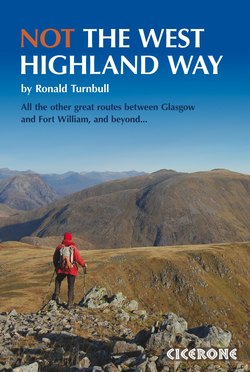Читать книгу Not the West Highland Way - Ronald Turnbull - Страница 10
На сайте Литреса книга снята с продажи.
ОглавлениеDRYMEN TO ROWARDENNAN
This short stage finishes crossing the Lowland plain and arrives at Loch Lomond. It’s the only section without a mountain alternative – unless we count 361m Conic Hill as a mountain.
Maybe we should. Conic offers a stiff steep climb, a sudden panorama, and a whole lot of rock on top. That stiff, steep climb is, though, a mere 50m above the WH Way path. This is scarcely enough for a subheading and a little blue route box with distances and times. And why should Conic require a little blue route box, when it’s got the huge blue expanse of Loch Lomond?
WH WAY: DRYMEN TO ROWARDENNAN
| Distance | 24km (15 miles) |
| Approximate time | 7hr |
Conic Hill from south of Luss
Loch Lomond from Conic Hill
After the rail-and-road travel of the previous section, today starts with something even less exciting: a wood-pulp plantation. Leave Drymen on the main A811 for a path on the left up into Garadhban Forest.
The forest track contours northwest, through a car park and past various side-tracks. Emerge into a patch of clear-fell, and the official Way’s first view of Loch Lomond lies below the brushwood. Here I met two Germans encamped in what had been, before the trees fell, a clearing: a point marked on Harvey’s strip map as a wild campsite. I was pleased to tell them that, since the Land Reform Act of 2003, the whole of Scotland is a wild campsite. For myself, I continued into the darkness to a comfortable heather bed on the slopes of Conic Hill.
After the gate onto open moorland, the path becomes surprisingly rough, and not even very distinct at first. It tends uphill then bends round left onto the end of Conic Hill.
Small hill side-trip: Conic Hill
Conic is the final leaping-upwards of the Lowlands. It’s a slice of pebbly conglomerate, tipped on edge to form a spiky spine right down to Balmaha. The hill could be (but isn’t) nicknamed as Conic the Hedgehog.
Leave the WH Way as it starts to slant round onto the right-hand slope of the hill, to ascend grassy heather to the summit; or else from the WH Way’s high point, a small path leads back sharp left up to a col and the summit just beyond.
The summit features in the hill list of Marilyns: though only 361m high, it has the required 150m of drop all around it. Most Marilyns have fine views, and Conic’s is a panorama of Loch Lomond. Ahead and below, the hill spine continues as a line of islands across the loch. Conic Hill and its islands are taken as marking the boundary between Lowlands and Highlands. On a clear day, that line can be extended beyond Loch Lomond to the distant Isle of Arran, also split into Lowland and Highland halves.
Descend southwest to the first col. Here the path leads down to the right to rejoin the WH Way; but for the full Conic tonic, continue down the hill spine, enjoying the views and being disconcerted by the bare conglomerate rocks on the steeper descents. The water-smooth cobbles embedded in the rock are of pale quartzite and dark lava. They were washed by flash floods out of a mountain range to the north that no longer exists. The quartzite cobbles are particularly slippery.
After 1km, slant down to the right to rejoin the WH Way, just as it bends back to the left to slant through a grassy col in the spine ridge.
The descent to Balmaha is not the Way’s longest one – that distinction goes to the descent from the Devil’s Staircase to Kinlochleven (see page 94). But it is the second longest, and the steepest, and coming so early on is undoubtedly the toughest. Even those planning all the ambitious big-hill byways for later on may find this downhill section bringing their knees (as it were) to their knees.
After bypassing the summit, the wide WH Way path continues down just to right of Conic’s summit ridge. It is muddy and sometimes on bare conglomerate (or ‘puddingstone’) rock. It passes down leftwards through a grassy col and then into woods. Cross Balmaha car park, whose visitor centre has a sculpture symbolising the Highland Line in just two large stones, one of the Lowland Old Red Sandstone and the other of Highland schist.
From the lane to Balmaha pier, the path climbs over Craigie Fort, a fine viewpoint. And now we’re in the Highlands. Specifically we’re on Loch Lomond side, as rampaged over by Rob Roy Macgregor. But the woodland paths are well laid, the wild wolves extinct. Nothing lurks among the oaks but a sudden glimpse of Loch Lomond; and even the plumpest and most affluent West Highland walker probably won’t be molested by any cattle-reiving bandit. Reiving (Scots): snatching away, thieving, especially of livestock. The victim is ‘bereived’, and may well over the coming winter be dying of hunger.
North of Milarrochy’s shingle bay the way runs sometimes alongside the small tarred road, but mostly just far enough in the woods to be out of earshot. The path rejoins the road for half a mile, to the large car park at Rowardennan Pier.
